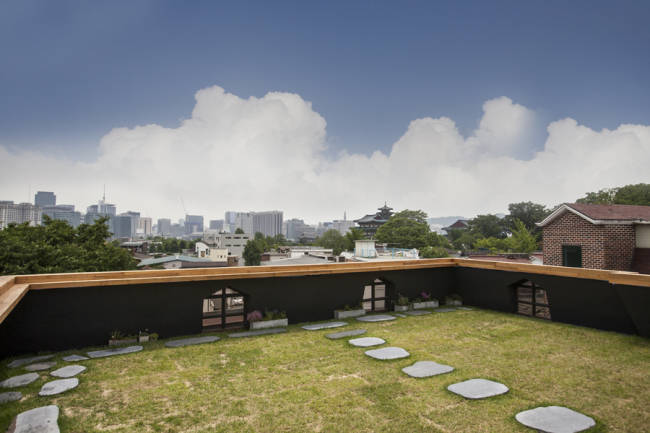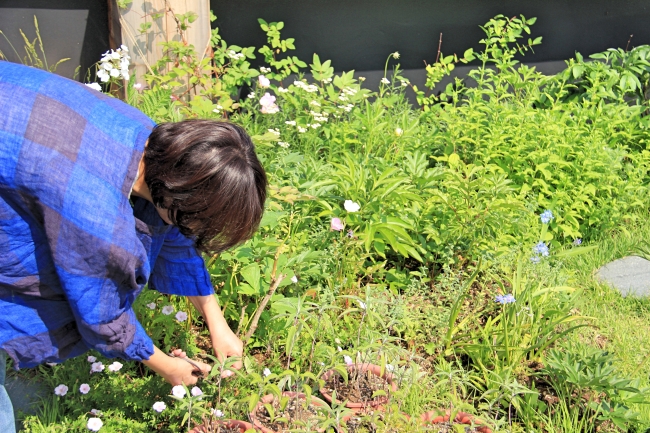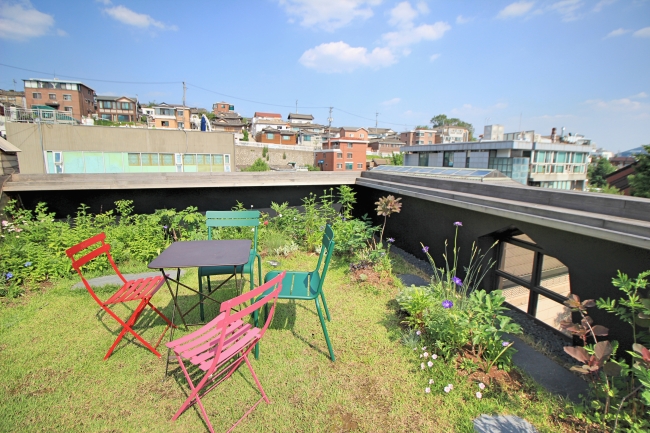[Weekender] Creating the ultimate skyline garden paradise
By Korea HeraldPublished : June 3, 2016 - 15:46
As a major urban city, Seoul’s dense quarters leave little space for those with green thumbs to enjoy the relaxing pleasures of gardening within the confines of one’s home.
However, one of the latest trends in combating Seoul’s lack of space is to utilize one’s rooftop. There are an increasing number of private homes independently creating their own rooftop Gardens of Eden, separate from the Seoul Metropolitan Government’s “Rooftop Greening Project” that seeks to revitalize public and private rooftops across the city with gardens.
However, one of the latest trends in combating Seoul’s lack of space is to utilize one’s rooftop. There are an increasing number of private homes independently creating their own rooftop Gardens of Eden, separate from the Seoul Metropolitan Government’s “Rooftop Greening Project” that seeks to revitalize public and private rooftops across the city with gardens.

With more citizens looking to spruce up their rooftops with a bit of natural splendor, one can’t help but wonder what goes into maintaining such areas and whether it is a job that can be accomplished by a novice as a do-it-yourself project.
For Kim Jung-hwan, the owner of a local bed-and-breakfast, the answer is a resounding yes.
Tucked away in the heart of Seoul’s popular hanok village in Samcheong-dong is A House BnB.
Although you would never guess it while walking down the street, the small six-bedroom guesthouse boasts one of the neighborhood’s most beautiful rooftops.
“While I have always liked flowers, I had no previous experience gardening at all before I decided to try and make a rooftop garden,” Kim told The Korea Herald. “And to be honest it wasn’t that difficult. At first I hired a professional to take a look at the area and to give me advice on how I needed to go about things and how I should design it.”

“From there, I mostly relied on reading books and searching online to learn how other people had successfully created their gardens and got tips from them,” she continued.
“I also used to go to Yangjae Flower Market and I would ask workers there a lot of questions. ... I think I may have annoyed them a bit but I learned a lot,” Kim said with a smile.
She took over the guesthouse about two years ago and decided to completely revamp the property, including adding a garden on its rooftop, which was previously a desolate concrete open space. Kim even uses the plants grown on the roof to create decorative flower bouquets for guestrooms.
With a couple of stones, some grass, rows of flower beds and a little bit of research, Kim managed to transform the building’s roof into one of the bed-and-breakfast’s biggest selling points. It even offers stunning views of Gyeongbokgung Palace and Bukhansan Mountain as an added bonus.

Kim said it cost her roughly 5 million won ($4,200) to complete the basic setup of the garden, including waterproofing the area, laying soil and planting grass.
An important tip for those looking to follow in Kim’s footsteps is to ensure there is a proper layer of waterproof material to lay out on the roof prior to adding any soil. As every rooftop is different, it would be wise to consult a professional to get exact specifications for proper waterproofing.
“We were very careful to waterproof the roof before laying down the soil,” said Kim. “We then laid out soil about 20 cm thick before planting the grass.”
“One of the most important things in maintaining a rooftop garden is dedication,” she added. “When first starting out, I had to tend to the garden every single day, but now I only have to work on it around three times a week for about two to three hours a day.”
Kim revealed that she even went so far as to cutting grass on the rooftop completely by hand, a task which took her around two days to complete.

“The shape and look of the grass is very different when you cut with a machine than when you cut by hand. I like doing it by hand because it gives me more control.
Her ambitions for her small-scale garden are growing too. She hopes to one day be able to have produce that can be used in her bed-and-breakfast’s in-house cafe.
“I recently just planted some basil,” she said whilepicking off some leaves that gave off an intoxicating, earthy aroma. “I really like herbs and it occurred to me that if I start growing a couple of herbs here and there, then I could take these and use them at our cafes downstairs, maybe for sandwiches.”
“The rooftop is hot in the summer and cold in the winter so all kinds of herbs grow well,” Kim said. “As for flowers, my favorite is peonies, I find they blossom really well on my rooftop.”
Another Samcheong-dong resident looking to add a dash of color and life into her rooftop is Lee Yoon-sun, who has lived in a shared housing complex in Samcheong-dong for the past five years.
She shares a common rooftop with her housemates.
Lee has scattered several potted plants around the rooftop, but she hopes that one day it will also house greens.
“One of the things I really wanted to do with our rooftop was to grow various greens that I could use for cooking,” said Lee. “However, I was informed by a gardening expert friend of mine that our rooftop, as it is, is not suited for growing vegetables. So now I’m looking for some new ways in which our rooftop can be transformed into something practical and fun for the whole house to enjoy.”
“I think one of its biggest perks is the fact that in Seoul, houses that have a garden are considered better because even if it’s just a small space, being able to incorporate that outdoor space into your home is always a plus,” she added.
By Julie Jackson (juliejackson@heraldcorp.com)
-
Articles by Korea Herald


![[AtoZ into Korean mind] Humor in Korea: Navigating the line between what's funny and not](http://res.heraldm.com/phpwas/restmb_idxmake.php?idx=644&simg=/content/image/2024/04/22/20240422050642_0.jpg&u=)


![[Exclusive] Korean military set to ban iPhones over 'security' concerns](http://res.heraldm.com/phpwas/restmb_idxmake.php?idx=644&simg=/content/image/2024/04/23/20240423050599_0.jpg&u=20240423183955)
![[Herald Interview] Why Toss invited hackers to penetrate its system](http://res.heraldm.com/phpwas/restmb_idxmake.php?idx=644&simg=/content/image/2024/04/22/20240422050569_0.jpg&u=20240422150649)
![[Graphic News] 77% of young Koreans still financially dependent](http://res.heraldm.com/phpwas/restmb_idxmake.php?idx=644&simg=/content/image/2024/04/22/20240422050762_0.gif&u=)







![[Exclusive] Korean military to ban iPhones over security issues](http://res.heraldm.com/phpwas/restmb_idxmake.php?idx=652&simg=/content/image/2024/04/23/20240423050599_0.jpg&u=20240423183955)



![[Today’s K-pop] Ateez confirms US tour details](http://res.heraldm.com/phpwas/restmb_idxmake.php?idx=642&simg=/content/image/2024/04/23/20240423050700_0.jpg&u=)